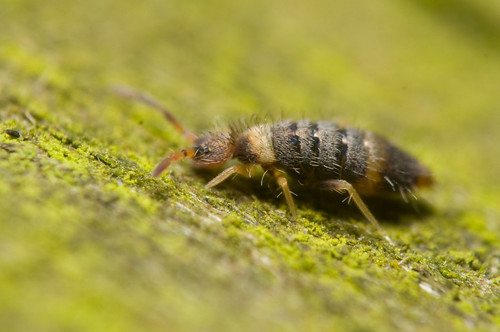A couple of hours over the weekend opened up an opportunity for the BTO to start on the 'Big Six' - the isopod big six that is. Over the course of the year we would expect to turn up the six most commonly recorded and widely distributed woodlice species with, fingers crossed, one or two of the less common ones found as well.
The piece of damp woodland and fen at the top of the BTO reserve was the starting point. Despite the high winds and freshly fallen timber, valour won the day over discretion and a start was made. Working over loose-barked fallen logs I soon had several pots of woodlice, plus a few myriapods, a couple of ground beetles and one specimen of the Black Snail Beetle (
Silpha atrata - which, despite its name, also has a red form).
Back at home, radio on and the Saturday afternoon footie for company, I worked through the woodlice, keying them out. Three of the big six were represented in the sample:
Porcello scaber,
Oniscus asellus and
Philoscia muscorum. Also present were two other species.
Trichoniscus pusillus agg. and the rather local
Ligidium hypnorum. The latter has a SE distribution and is most common SE of a line from the Wash to the Isle of Wight, with a more W distribution S of a line from the Thames to the Severn. RSPB could struggle to get this one but it might well be lurking somewhere around Sandy. If it is then that could be a really good record. It is a species of waterlogged habitats like damp meadows and riverine woodlands, and is surface active.
Trichoniscus pusillus is known to occur in two distinct races, the sexual
provisorius and the parthenogenic
pusillus. Most authors treat these two races as forms (but Schmalfus (2004) elevates them to full species status) and they are lumped together as
T. pusillus agg. by Gregory (2006). Given that Gregory is the Isopod Guru, we'll go with him.
Plans are now afoot to find the remaining three species of the big six!
 Two Oystercatchers clearly visible from the Plateau at The Lodge. The above shot digiscoped with the mighty power of my Swarovski! Below you can see where Derek's Whites Eggs Pit is as viewed from our spot on the Plateau (its the watery streak in the middle-distance).
Two Oystercatchers clearly visible from the Plateau at The Lodge. The above shot digiscoped with the mighty power of my Swarovski! Below you can see where Derek's Whites Eggs Pit is as viewed from our spot on the Plateau (its the watery streak in the middle-distance).





